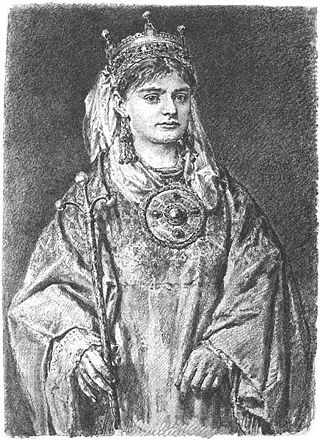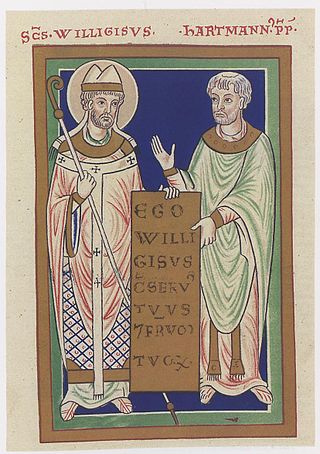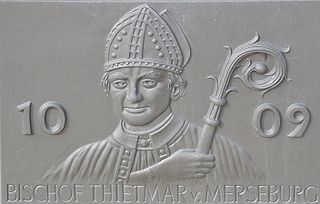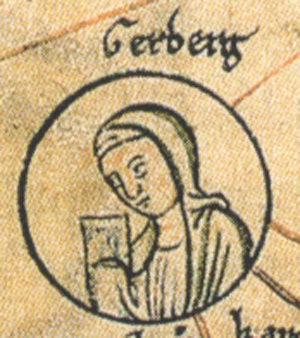Warin (died 9 September 984) was the Archbishop of Cologne, Germany, from 976 to 984. [1]
Warin (died 9 September 984) was the Archbishop of Cologne, Germany, from 976 to 984. [1]
Warin's origins are not recorded. He became a cleric of the Cathedral in Cologne.
Warin became the Archbishop of Cologne in 976. In 983 the Holy Roman Emperor Otto II entrusted Warin with the education of his son and heir Otto. He crowned Otto as king of Germany in Aachen on Christmas Day of that year. However, after Otto II's death in 984, he handed Otto III to Henry the Saint and supported the latter's overtures to the German throne.
Warin died in 984 and was buried in the Abbey of St. Martin.

Theophanu was empress of the Holy Roman Empire by marriage to Emperor Otto II, and regent of the Empire during the minority of their son, Emperor Otto III, from 983 until her death in 991. She was the niece of the Byzantine Emperor John I Tzimiskes. She was known to be a forceful and capable ruler. Her status in the history of the Empire in many ways was exceptional. According to Wilson, "She became the only consort to receive the title 'co-empress', and it was envisaged she would succeed as sole ruler if Otto II died without a son."

Year 984 (CMLXXXIV) was a leap year starting on Tuesday of the Julian calendar.

Year 976 (CMLXXVI) was a leap year starting on Saturday of the Julian calendar.

Otto III was Holy Roman Emperor from 996 until his death in 1002. A member of the Ottonian dynasty, Otto III was the only son of the Emperor Otto II and his wife Theophanu.

Otto II, called the Red, was Holy Roman Emperor from 973 until his death in 983. A member of the Ottonian dynasty, Otto II was the youngest and sole surviving son of Otto the Great and Adelaide of Italy.

Richeza of Lotharingia was a member of the Ezzonen dynasty who became queen of Poland as the wife of Mieszko II Lambert. Her Polish marriage was arranged to strengthen the ties between Mieszko and her uncle Emperor Otto III. She returned to Germany following the deposition of her husband in 1031, either divorcing or separating from him. Upon the death of her brother Duke Otto II of Swabia and the consequent extinction of the male line of her family, Richeza became a nun, worked to preserve the Ezzonen heritage, and funded the restoration of the Abbey of Brauweiler. She has been beatified.

Henry II, called the Wrangler or the Quarrelsome, a member of the German royal Ottonian dynasty, was Duke of Bavaria from 955 to 976 and again from 985 to 995, as well as Duke of Carinthia from 989 to 995.

Lothair, sometimes called Lothair II, III or IV, was the penultimate Carolingian king of West Francia, reigning from 10 September 954 until his death in 986.

The Archbishop of Cologne is an archbishop governing the Archdiocese of Cologne of the Catholic Church in western North Rhine-Westphalia and is also a historical state in the Rhine holding the birthplace of Beethoven and northern Rhineland-Palatinate in Germany and was ex officio one of the Prince-electors of the Holy Roman Empire, the Elector of Cologne, from 1356 to 1801.

Leopold I, known as the Illustrious was a member of the House of Babenberg who ruled as Margrave of Austria from 976 until his death. He was the first margrave of the Babenberg dynasty which ruled the March and Duchy of Austria until its extinction in 1246.

Willigis was Archbishop of Mainz from 975 until his death as well as archchancellor of the Holy Roman Empire.

Thietmar, Prince-Bishop of Merseburg from 1009 until his death, was an important chronicler recording the reigns of German kings and Holy Roman Emperors of the Ottonian (Saxon) dynasty. Two of Thietmar's great-grandfathers, both referred to as Liuthar, were the Saxon nobles Lothar II, Count of Stade, and Lothar I, Count of Walbeck. They were both killed fighting the Slavs at the Battle of Lenzen.

Gerberga of Saxony was a Queen of France by marriage to Louis IV of France between 939 and 954. She ruled as regent of France during the minority of her son Lothair in 954–959.
Ebergar was the Archbishop of Cologne Germany, from 984 to 999.

Gero was Archbishop of Cologne from 969 until his death.

Herman II, a member of the Ezzonid dynasty, was Archbishop of Cologne from 1036 until his death. According to historian Henryk Zieliński, Hermann was the most influential of the German metropolitans.
Conrad of Wittelsbach was the Archbishop of Mainz and Archchancellor of Germany from 20 June 1161 to 1165 and again from 1183 to his death. He was also a cardinal of the Roman Catholic Church.

The House of Limburg-Stirum, which adopted its name in the 12th century from the immediate county of Limburg an der Lenne in what is now Germany, is one of the oldest families in Europe. It is the eldest and only surviving branch of the House of Berg, which was among the most powerful dynasties in the region of the lower Rhine during the Middle Ages. Some historians link them to an even older dynasty, the Ezzonen, going back to the 9th century.

Thietmar (II) (c. 925 – 3 August 979) was Margrave of Meissen from about 976 until his death.